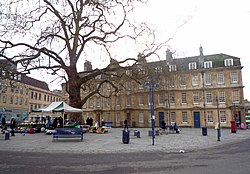
Bath is a city in the ceremonial county of Somerset, in England, known for and named after its Roman-built baths. At the 2021 Census, the population was 94,092. Bath is in the valley of the River Avon, 97 miles (156 km) west of London and 11 miles (18 km) southeast of Bristol. The city became a UNESCO World Heritage Site in 1987, and was later added to the transnational World Heritage Site known as the "Great Spa Towns of Europe" in 2021. Bath is also the largest city and settlement in Somerset.
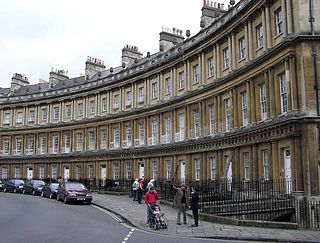
The Circus is a historic ring of large townhouses in the city of Bath, Somerset, England, forming a circle with three entrances. Designed by architect John Wood, the Elder, it was built between 1754 and 1768, and is regarded as a pre-eminent example of Georgian architecture. "Circus" means a ring, oval or circle in Latin. The construction has been designated as a Grade I listed building.
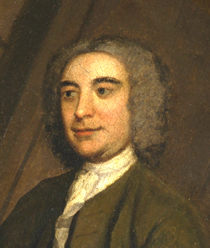
John Wood, the Elder was an English architect, working mainly in Bath.
John Pinch was an architect working mainly in the city of Bath, England. He was surveyor to the Pulteney and Darlington estate and responsible for many of the later Georgian buildings in Bath, especially in Bathwick.
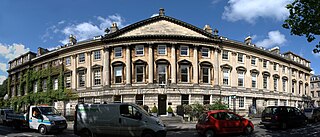
Queen Square is a square of Georgian houses in the city of Bath, England. Queen Square is the first element in "the most important architectural sequence in Bath", which includes the Circus and the Royal Crescent. All of the buildings which make up the square are Grade I listed.

The Grade I listed buildings in Somerset, England, demonstrate the history and diversity of its architecture. The ceremonial county of Somerset consists of a non-metropolitan county, administered by Somerset County Council, which is divided into five districts, and two unitary authorities. The districts of Somerset are West Somerset, South Somerset, Taunton Deane, Mendip and Sedgemoor. The two administratively independent unitary authorities, which were established on 1 April 1996 following the breakup of the county of Avon, are North Somerset and Bath and North East Somerset. These unitary authorities include areas that were once part of Somerset before the creation of Avon in 1974.

Bath and North East Somerset is a unitary authority created on 1 April 1996, following the abolition of the County of Avon, which had existed since 1974. Part of the ceremonial county of Somerset, Bath and North East Somerset occupies an area of 220 square miles (570 km2), two-thirds of which is green belt. It stretches from the outskirts of Bristol, south into the Mendip Hills and east to the southern Cotswold Hills and Wiltshire border. The city of Bath is the principal settlement in the district, but BANES also covers Keynsham, Midsomer Norton, Radstock and the Chew Valley. The area has a population of 170,000, about half of whom live in Bath, making it 12 times more densely populated than the rest of the area.
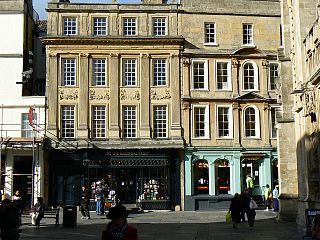
Marshal Wade's House or General Wade's House at 14 Abbey Church Yard, Bath, Somerset, England was built around 1700 and has been designated as a Grade I listed building.

Gay Street in Bath, Somerset, England, links Queen Square to The Circus. It was designed by John Wood, the Elder in 1735 and completed by his son John Wood, the Younger. The land was leased to the elder Wood by Robert Gay, MP for Bath, and the street is named after him. Much of the road has been designated as Grade I listed buildings.

Duke Street in Bath, Somerset, England was built in 1748 by John Wood, the Elder. Several of the buildings have been designated as Grade I listed buildings. The street, which overlooks the River Avon, is pedestrianised with no vehicles permitted to enter.

North Parade in Bath, Somerset, England is a historic terrace built around 1741 by John Wood, the Elder. Several of the houses have been designated as Grade I listed buildings.

South Parade in Bath, Somerset, England, is a historic terrace built around 1743 by John Wood, the Elder. All of the houses have been designated as Grade I listed buildings.

Stall Street in Bath, Somerset, England was built by John Palmer between the 1790s and the first decade of the 19th century. The buildings which form an architectural group have listed building status and are now occupied by shops and offices.

The Paragon in the Walcot area of Bath, Somerset, England is a street of Georgian houses which have been designated as listed buildings. It was designed by Thomas Warr Attwood. It now forms part of the A4.
John Strahan was an architect working in Bristol and Bath, England, in the early 18th century. He died around 1740.

Henrietta Street in the Bathwick area of Bath, Somerset, England was built around 1785 by Thomas Baldwin.

Johnstone Street in the Bathwick area of Bath, Somerset, England was designed in 1788 by Thomas Baldwin, with some of the buildings being completed around 1805-1810 by John Pinch the elder.

Trim Street in Bath, Somerset, England is an historic street, built in 1707, of shops and houses, many of which are listed buildings. It was named after George Trim who owned the land.

Upper Borough Walls is a historic street in Bath, Somerset, England. Many of the structures are listed buildings.
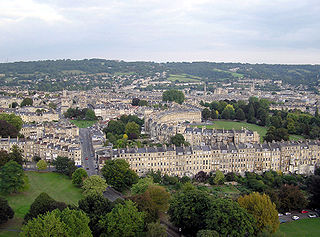
The buildings and architecture of Bath, a city in Somerset in the south west of England, reveal significant examples of the architecture of England, from the Roman Baths, to the present day. The city became a World Heritage Site in 1987, largely because of its architectural history and the way in which the city landscape draws together public and private buildings and spaces. The many examples of Palladian architecture are purposefully integrated with the urban spaces to provide "picturesque aestheticism". In 2021, the city was added to a second World Heritage Site, a group of historic spa towns across Europe known as the "Great Spas of Europe". Bath is the only entire city in Britain to achieve World Heritage status, and is a popular tourist destination.
